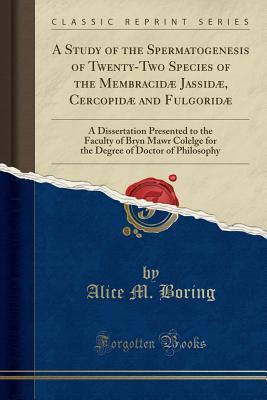Read A Study of the Spermatogenesis of Twenty-Two Species of the Membracid� Jassid�, Cercopid� and Fulgorid�: A Dissertation Presented to the Faculty of Bryn Mawr Colelge for the Degree of Doctor of Philosophy (Classic Reprint) - Alice M Boring | ePub
Related searches:
Spermatogenesis in the Testes of Diapause and Non-Diapause
A Study of the Spermatogenesis of Twenty-Two Species of the Membracid� Jassid�, Cercopid� and Fulgorid�: A Dissertation Presented to the Faculty of Bryn Mawr Colelge for the Degree of Doctor of Philosophy (Classic Reprint)
The biology of spermatogenesis: the past, present and future
Quantitative Analysis of Spermatogenesis and Apoptosis in the
A study of the spermatogenesis of Coptocycla aurichalcea and
Progress and future prospect of in vitro spermatogenesis Oncotarget
STUDIES ON INSECT SPERMATOGENESIS - The University of
handout 5 - testes and spermatogenesis - Animal & Dairy Sciences
Male infertility, impaired spermatogenesis, and azoospermia in - JCI
Exam 5: Spermatogenesis and Oogenesis Flashcards by Anika
SPERMATOGENESIS Spermatogenesis is the process of sperm cell
Spermatogenesis and Oogenesis Video explained - Entrytest.com
Spermatogenesis, the Development of Sperm, Illustrated - Illustrations
A study of the spermatogenesis of Common Indian frog (Rana
A study of the spermatogenesis of twenty‐two species of the
Study of spermatogenesis and thickening of lamina propria in
4044 3229 3631 4869 4598 1872 3312 324 3890 2248 469 3848 833 4543 3590 1937 4628 1933 3253 2150 1253 2913 4781 829 994 2327 4069 319 4155
Spermatocytogenesis: in seminiferous tubules the stem cells adjacent to the inner tubule wall divide in a centripetal direction, that means it begins from the outer.
The negative correlation between the thickness of the lamina propria and johnsen's score count in individual seminiferous tubules was observed and the tubules with thin lamina propria indicated almost complete spermatogenesis. It is suggested that the thin lamina propria may be one of the good indicators of complete spermatogenesis.
If you have ever wondered how a baby is born, then it is important to know the process of reproduction in-depth.
Spermatogenesis is the process of the production of sperms from the immature germ cells in males. It takes place in seminiferous tubules present inside the testes. During spermatogenesis, a diploid spermatogonium (male germ cell) increases its size to form a diploid primary spermatocyte.
A study of the spermatogenesis of twenty‐two species of the membracidæ, jassidæ, cercopidæ and fulgoridæ, with especial reference to the behavior of the odd chromosome.
Our studies further reveal that sbf1 is specifically required for spermatogenesis through contributions to male germ cell differentiation and survival.
Within the seminiferous tubule, germ cells are arranged in a highly ordered sequence from the basement membrane to the lumen.
Testosterone, re- leased by leydig cells and potentially testicular macrophages, appears to play an essential role in a spermiation-ssc differentiation axis, as well.
May 8, 2019 when a male reaches adolescence, hormones from the anterior pituitary activates the production of sperm cells (and continues up to senility).
Aug 12, 2018 so, it was the first report showing male germ cells passing through the transition from spermatogonial phase to the meiotic prophase in vitro.
Spermatogenesis is the process of formation of haploid, microscopic and motile gametes, called spermatozoa, from the diploid spermatogonia of the testis of male.
Testosterone secreted by leydig cells has a negative feedback.
A study of spermatogenesis in podophyllum: including laboratory methods of preparation.
A comprehensive approach to the study of molecular, cellular, and organ system interactions with a special focus on topics covered on the usmle and comlex.
A spermatogenic cycle is defined as the time it takes for the reappearance of the same stage within a given segment of the tubule.
The spermatids mature into spermatozoa by a process called spermiogenesis with four sperm cells resulting from each primary spermatocyte.
As a congruent model to study spermatogenesis and identify the genes and disorganization of germ cells, and hypospermatogenesis.
These stages are sequentially arranged along the length of a tubule: “wave of spermatogenesis”. The duration of this wave is the “cycle of spermatogenesis”.
Spermatogenesis is the process of making sperm cells, or developing immature germ cells known as spermatogonia into mature sperm cells called spermatozoa. A sperm cell is the male reproductive cell that fertilizes the female egg in sexual reproduction.
Nov 5, 2019 during spermatogenesis, a diploid spermatogonium (male germ cell) increases its size to form a diploid primary spermatocyte.
This observational study will compare spermatogenesis in male adult renal transplant recipients receiving valganciclovir versus untreated matched controls.
Egg and sperm are initially produced through a process called meiosis.
In this investigation, we aimed to characterize for the first time spermatogenesis through quantitative data on testicular germ cell.
Crucial to spermatogenesis are a number of rna binding proteins, which are expressed in germ cells.
The gametogenic function of the testes is to produce the male gametes or spermatozoa.
Each of these secondary spermatocytes then undergoes meiosis ii to produce a total of four spermatids. With the help of sertoli cells, the haploid spermatids then.
Learn vocabulary, terms, and more with flashcards, games, and other study tools. Undergo mitosis to produce 2 diploid cells called secondary spermatocytes.
Sep 12, 2017 in vitro production of haploid male germ cell is a powerful tool, not only for the treatment of infertility including oligozoospermic or azoospermic.
Aug 30, 2020 neet biology spermatogenesis multiple choice questions make you feel (a) spermatocytes – spermatids – spermatogonia – spermatozoa.
Elegans spermatozoa move by crawling using a single pseudopod. Wild-type spermatogenesis and its defects in mutants can be studied.
Just like spermatogenesis, oogenesis involves the formation of haploid cells from an original diploid cell, called a primary oocyte, through meiosis.
This population contains both stem cells and differentiating spermatogonia, which undergo a series of mitotic divisions to amplify the number of cells.
Jul 10, 2020 production of functional, haploid sperm is a major prerequisite for male reproduction.

Post Your Comments: